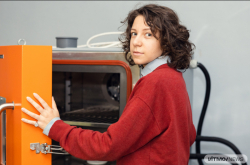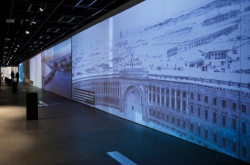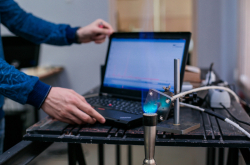ITMO's Laboratory of Alignment and Assembly of Light-Guided Photonic Devices was founded in 2015. What prompted its creation at that exact time?
The laboratory was created as a subdivision of the Research Institute of Light-Guided Photonics. At that time, they wanted to launch a laboratory dedicated to the alignment and assembly of devices for the production of fiber-optical interference-type sensors, which are high-precision sensors that have to meet the highest requirements.
Naturally, we didn't create the lab out of thin air. At that time, I was already involved in the microassembly of fiber elements and development of the associated technological equipment, and we already had the necessary science and technology infrastructure to set up a full-fledged laboratory.
Today's photonics is a rapidly developing field that offers many ambitious challenges. Can you tell us what makes this field so relevant?
Light-guided photonics is a field that is currently focused on creating new measurement systems for all kinds of physical values: acoustic, mechanical, electromagnetic and, naturally, optical.

A good example of that would be the invention of the fiber-optical gyroscope. A regular mechanical gyroscope is a large spinning object that can be used to find the angle deviations from its spinning axis. Such systems are used in navigation; for example, they can help maintain a ship's course. In the 1960s, new optical devices started to replace these traditional gyroscopes. The first navigational device of this type was the ring laser gyroscope, praised for its high precision and small size. Yet today's light-guided photonics offer a whole new level of quality. Most importantly, this has to do with increasing the precision of fiber optical gyroscopes, which is essential for the development of new high-precision navigation systems.
In the past ten years, our team focused on the development of designs and manufacturing technologies for fiber-optical gyroscopes on the order of Concern CSRI Elektropribor JSC. As of now, such devices are already being mass-produced, and we are focusing on studying the particular elements of these gyroscopes in order to further improve their accuracy.

Our other task has to do with creating a marine hydroacoustic towed streamer for exploration seismology. This is a fiber-optical cable of great length, up to several kilometers, made up of an array of point detectors that work as a huge distributed antenna that receives acoustic waves reflected from the seabed or the Earth's deep layers. Such data is then used to model a cross-section of the seabed. This can be applied in geological exploration, searching for oil, gas and other natural resources, and especially in exploration of hard-to-reach regions of the Far North.
Apart from gyroscopes and hydroacoustics, fiber optics can offer a good alternative to traditional measurement tools of the electric power industry. This field is most promising, as it offers many new research and technological tasks.

So, what are your laboratory’s current areas of focus?
The first is studying the properties of such optical components as optical fibers, integrated waveguides, semiconductor lasers, and light detectors. The second has to do with alignment and combining of these optical components for the purposes of assembling measurement devices that our center's other laboratories will work on.
We also conduct educational and research activities with the students from the Faculty of Laser Photonics and Optoelectronics, and we are ready to work with other students who are interested in the field of fiber optics, as well.
What's important here is that we start working with them when they are on their second or third year at the university, as in order to become good specialists and make a conscious choice of their Master's and PhD programs, the students have to start working in their field of choice as early as possible. Most members of our laboratory have once done the same.

On the whole, light-guided photonics exist at an intersection of several research fields: optics, electronics, programming, and network technologies. Which competencies should students and specialists in this field possess?
First of all, they need fundamental knowledge in the field of physics and optics: fiber and integrated optics, the fundamentals of radiation propagation, optical sources, and receivers.
From the field of electrical engineering, they have to have a keen understanding of Ohm's Law, telecommunications theory, the operation of optical sensors, and know such things as how to launch a semiconductor laser, for example. They also need programming skills, as these are essential for creating new electronic devices.
For modeling optical systems, they need advanced knowledge in theoretical optics and mathematics, as well as special skills in the field of optical modeling in such systems as Zemax and COMSOL Multiphysics.

As you see, this is quite a range of skills that encompasses several different research fields.
You've already mentioned that the Research Center for Light-Guided Photonics has many industrial partners. Which companies does your laboratory collaborate with?
We collaborate with all of the Center's industrial partners. These are such enterprises as Concern CSRI Elektropribor JSC, the Ioffe Institute, Vavilov State Optical Institute and others.
As for Concern CSRI Elektropribor JSC, we are also collaborating with them in the field of personnel training: many of our graduates are currently employed by this enterprise. We are also developing our collaboration with Technopark-Mordovia, and train personnel for working at enterprises in Saransk (Russia's major center of the fiber-optic industry).

What are the laboratory's development prospects?
We are planning to develop our competencies in assembling various optoelectronic devices that make use of optical fiber: lasers, optical sensors, integral optical waveguides. Nowadays, the task of creating reliable, high-performance building blocks with fiber-optical components is a most relevant one, and the Laboratory of Alignment and Assembly of Light-Guided Photonic Devices already has the necessary infrastructure and competencies for the complete cycle of creating modern fiber-optical devices.





